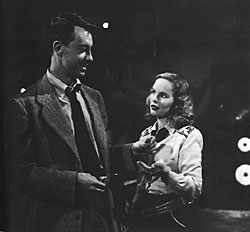
A Hole in the Head (1959)
Director: Frank Capra
There is no shortage of stories about reaching for the American dream. Willy Loman and Jay Gatsby are two of the 20th century's most self-deluded climbers toward the promised land. Their creators, Arthur Miller and F. Scott Fitzgerald, were men of letters and, significantly, both American. Being born inside the dream, both could see its soft underbelly and weep.
Frank Capra is another matter. A Sicilian, he came to the promised land with his parents in 1903 and became the picture-perfect fulfillment of the American dream on which its native sons had gone sour. His films tend to affirm the greatness of America, where you're never out of the game and where a cynical heart will be reborn before the final frame. People feel good when they finish a Capra film because it is their cynical hearts he is working on, the grateful immigrant boy made good telling his troubled neighbors "you don't know what trouble is. This is paradise!"
A Hole in the Head is a later entry in the Capra oeuvre, but it has a familiar sound. This is It's a Wonderful Life transposed to Florida. Tony Manetta (Frank Sinatra) is George Bailey's successor as the man who wants more out of life. His ambitions are greater than Bailey's--this film is from the prosperous post-WWII years, after all. Manetta wants to be a big shot. Instead, he's a widower on the verge of being evicted from the rundown hotel he manages. He's got a cute kid/buddy (Eddie Hodges) and a beatnik girlfriend (Carolyn Jones). When all his options fail, he calls his big brother Mario (Edward G. Robinson), a 5-and-dime mogul from New York, to bail him out.
Sinatra's character is that of a boy stubbornly clinging to his dreams. He lives like the bum his brother calls him, but we know he's really pure of heart because he won't give up his vision for his life. This stubbornness cost Willy Loman and Jay Gatsby their lives, but for Capra, the story turned out differently. His antiheroes always discover the richness that they have--usually in their human relationships. But A Hole in the Head cuts a little darker than other Capra films. The implied happy ending, during which Manetta is shown running down the beach with his son and a lovely widow (Eleanor Parker) he has just met, is smoke and mirrors. Manetta is still in deep trouble, financially and personally. He hasn't grown up; he doesn't seem to really connect on a personal level to anyone, even his son. The only real difference between him and Mr. Potter is that he's broke and Potter isn't. He doesn't deserve a happy ending, even in Capra's world. But this is Hollywood and Capra, where everything comes out right and everyone has infinite chances to make good. Too bad. This could have been the anti-Capra movie he always should have made. l





